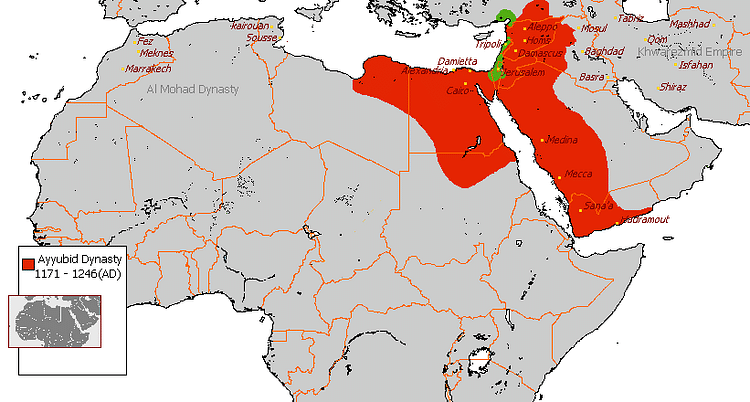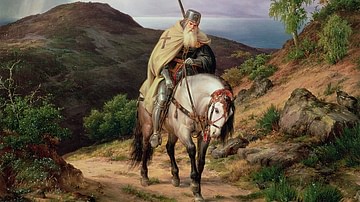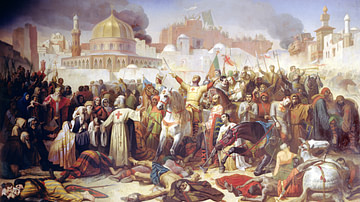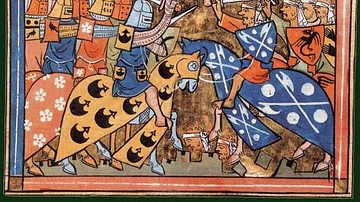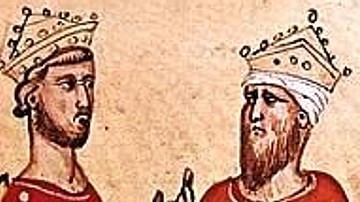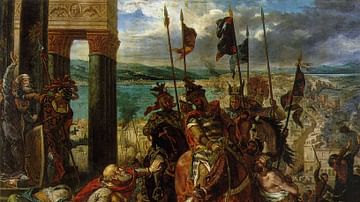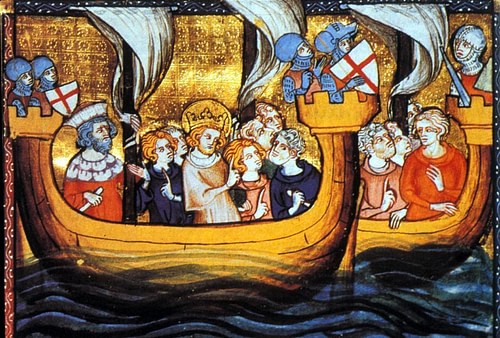
The Seventh Crusade (1248-1254 CE) was led by the French king Louis IX (r. 1226-1270 CE) who intended to conquer Egypt and take over Jerusalem, both then controlled by the Muslim Ayyubid Dynasty. Despite the initial success of capturing Damietta on the Nile, the Crusader army was, in 1250 CE, routed at Mansourah in a repetition of the events of the Fifth Crusade (1217-1221 CE). Louis was captured and then ransomed but remained determined to fulfil his Crusader vows, launching the Eighth Crusade in 1270 CE.
Prologue: The Fall of Jerusalem
The Sixth Crusade (1228-1229 CE) had been led by Holy Roman Emperor Frederick II (r. 1220-1250 CE) who managed to avoid any actual fighting and negotiate control of Jerusalem from the Sultan of Egypt and Syria, al-Kamil (r. 1218-1238 CE). 15 years later, though, trouble was brewing again as al-Kamil's successors fought to maintain the Ayyubid Empire which al-Kamil's uncle, Saladin, had founded in 1174 CE. As in the past, some Muslim cities not under Ayyubid control (notably Damascus) continued to form alliances of convenience with the Latin states in the Middle East.
The Ayyubid control of the Middle East was greatly strengthened when a large Latin army and its Muslim allies from Damascus and Homs was defeated at the battle of La Forbie (Harbiya) in Gaza on 17 October 1244 CE. Over 1,000 knights were killed in the battle, a disaster from which the Latin states struggled to recover from, thereafter. Jerusalem had already been taken from the Christians, this time by the Ayyubid allies, the nomadic Khorezmians (Khwarismians) on 23 August 1244 CE. Christians in the Holy City had been murdered and sacred sites desecrated. The Latin East, as the Crusader-created states in the Levant are collectively known, appealed to the West for help. Pope Innocent IV (r. 1243-1254 CE) responded and called for yet another crusade, the campaign now known as the Seventh Crusade. The leader of the expedition was Louis IX, king of France. Church figures went on the usual preaching tours to gather recruits across Europe, although France was the primary provider. Leading European nobles on the expedition would include Henry I of Cyprus (r. 1218-1253 CE), Raymond VII of Toulouse, Duke Hugh IV of Burgundy, Count William of Flanders, and Louis' own brother, Alphonse of Poitiers. It seemed that the failures of the previous crusades had not dampened the spirits of Europe's finest fighting men.
Louis IX, King of France
Just why, in December 1244 CE, Louis 'took up the cross' and decided to leave his kingdom for the Levant is not clear. According to legend, the king was seriously ill and the decision to embark on a crusade miraculously and instantly restored him to health. Modern historians look for less supernatural motivations such as the desire to be seen as Europe's foremost ruler, to consolidate his kingdom by restructuring its administration - a necessity in his long absence - or simply piety for the Christian cause. What is certain is that the king decided to form the Crusade even before the Pope officially called it, a reversal of the procedure of previous crusades.
The French king was determined that his expedition would be well-funded, and it would be, thanks to a series of tax reforms and tax hikes, income from the church (taxes and donations from the faithful), the requisition of 'gifts' from at least 82 towns across France, payments from barons and other nobles, and the king's own pocket. In 1248 CE the king, long known for his anti-Jewish policies, expelled all Jews from France and confiscated their property. No stone (or piggy bank) was left unturned, and the king certainly needed a vast amount of money to fund such a huge undertaking. Louis even went to the expense of constructing the fortified town of Aigues Mortes in southern France specifically for the Crusader army to assemble and disembark from in ships hired for the purpose from Genoa and Marseille. Supplies were also steadily gathered there. Louis' planning was further evidenced by his stockpiling of goods - especially wheat, barley, and wine - on Cyprus, all of which would be collected en route.
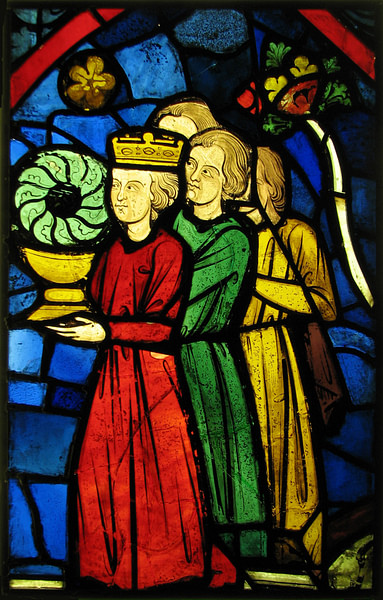
The armada set off on 25 August 1248 CE, the force of around 10,000 men stopping off at Cyprus and staying on the island for eight months for refit and resupply. The delay also allowed stragglers to join the main army from both Europe and the Middle East cities of Acre, Tripoli, and Antioch. In addition, Louis would benefit from the contribution of the military orders based in the Levant, the Knights Hospitaller, Knights Templar, and Teutonic Knights. By the summer of 1249 CE, the army was finally ready to begin the Crusade. Louis wrote to the Sultan of Egypt, boldly expressing his intention not just to take back Jerusalem but to conquer all of Egypt and the Levant:
I will assault your territory, and even were you to swear allegiance to the cross, my mind would not be changed. The armies that obey me cover mountains and plains, they are as numerous as the pebbles of the earth, and they march upon you grasping the swords of fate.
(quoted in Maalouf, 227)
Al-Salih, Sultan of Egypt
The Ayyubid dynasty was at this time led by al-Salih Ayyub (r. 1240 & 1245-9 CE), the second son of al-Kamil, his predecessor as Sultan of Egypt. Like his father, al-Salih struggled to keep control of his territories due to rivalries between Muslim leaders and even Ayyubid princes. In addition, the Mongol Empire was expanding ever-westwards and seemed unstoppable. Indeed, Louis IX had made some diplomatic overtures towards the Mongol khan in the hope that he might prove a useful ally in squeezing the Ayyubids out of Egypt and the Levant altogether, but the Mongols were interested only in conquest, whether it be of Christian or Muslim lands made no difference.
Fortunately, for the moment the Mongols remained a future threat and, regarding his own internal affairs, al-Salih could rely on his Mamluk regiment, the Bahris, and a very large number of Kipchak Turkish slave warriors taken from the Russian steppe, to enforce his will. Thus, the Sultan, already boosted by the victory at La Forbie, was able to take control of Damascus in 1245 CE, long-since a rebel Muslim stronghold. The decline of the Latin states continued apace when al-Salih captured Ascalon in 1247 CE.
Damietta
Louis' Crusader army landed in Egypt in June 1249 CE but met their first of many problems. The heavy and deep-bottomed sailing ships of the westerners meant that the army could not easily disembark to the sandy beaches of Egypt, and so knights were forced to wade through the shallows. Meanwhile, al-Kamil had been busy and reinforced the fortifications and the garrison of Damietta, the fortress city on the Nile Delta. Once all were assembled, the Crusader army now numbered around 18,000 men and included 2,500 knights and 5,000 crossbowmen. It was a large army for a single battle but not perhaps large enough to conquer an entire region.
As it turned out, the Crusaders captured Damietta in June 1249 CE with surprising ease. A combination of an amphibious attack and the superiority of western crossbows gave a remarkably quick victory considering the trouble it had taken the army of the Fifth Crusade to take Damietta in 1218-19 CE. An added bonus was that because the garrison had fled in panic, the city's fortifications remained intact. The Sultan's main army, though, waited at a safe distance from Damietta. This was only the opening move of what could be a very long game.
In the autumn of 1249 CE, al-Salih was dying at his camp at Mansourah (al-Mansura) on the Nile Delta, probably of tuberculosis. The people of Cairo were in a panic at the double blow of losing Damietta and now possibly their leader. Perhaps, at this moment, if Louis struck for the heart of the enemy, he might achieve total victory. As it was, the French king was still awaiting an important force belonging to his brother Alphonse, which did not arrive in Egypt until October. At least the annual Nile flood was by now abating, and so the way to Cairo was open. Louis, going against the advice of most of his nobles to see out the winter at the safety of Damietta, set off for Cairo on 20 November 1249 CE.
Mansourah & Defeat
The Crusaders made painfully slow progress along the Nile, most of the troops marching along the banks and those ships which could, carrying a huge quantity of supplies and equipment, followed alongside fighting against a contrary wind. At this point, the end of November 1249 CE, al-Salih died, succumbing to his illness. The officers of the Bahris, led by their commander Fakhr al-Din, then stepped in to smoothly continue the war against the Crusaders.
After 32 days, the Crusader army camped opposite the Muslim camp near Mansourah, itself protected by a branch of the river and fortifications. Both camps now used their huge catapult machines to bombard each other with artillery fire. Six weeks of sorties and relentless bombardment followed. A stalemate had been reached. Louis was offered a lifeline of hope by some Muslim defectors who informed him that the enemy camp could be approached from behind by crossing a ford further downstream.
On 8 February 1250 CE, the French king made his move and a large force of knights gathered at the spot on the river where the informers had indicated. Although having to dismount and have their horses swim across, an advance force of the knights made it to the other side. Then, their leader, Robert of Artois, made the stupid decision to immediately attack the enemy camp before the rest of the knights had crossed the river behind him. Although Fakhr al-Din was killed in the first attack, the rash decision by Robert to pursue the fleeing Muslim army as it made for the town of Mansourah proved his second and last mistake. Once inside the city, Robert's knights were hemmed in and, separated by the narrow streets, massacred. The Muslim army, regathering itself after the initial shock, then made a counterattack on Louis and his force of knights which had just crossed the river at the ford.
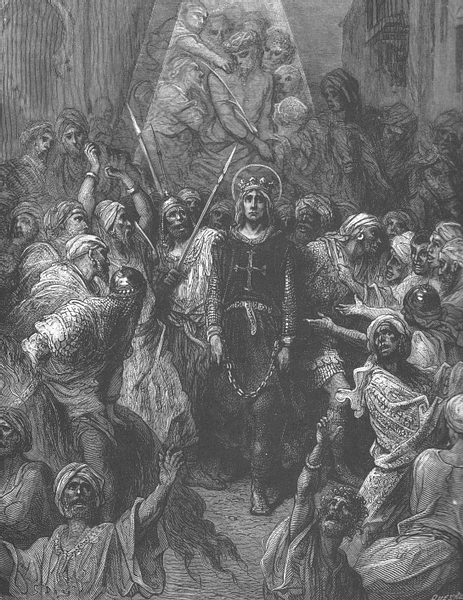
In the chaotic and bloody battle which followed, Louis only just managed to hold his ground until reinforcements arrived from the main Crusader camp at day's end. The Ayyubid army retreated to the safety of Mansourah but remained largely intact. In addition, by the end of February, the new Sultan and son of al-Salih, al-Mu'azzam Turan Shah, had arrived at Mansourah along with vital supplies and reinforcements. The Crusaders, on the other hand, had no means of resupply now that their camp had been cut off from Damietta by a fleet of Muslim ships, and soon starvation and disease were rife in their camp. Finally, on 5 April 1250 CE, Louis ordered a retreat. The western army, greatly reduced by disease, starvation, and constant attacks from the Ayyubid army, was, over two days, virtually wiped out as an effective force. The remaining Crusaders, only halfway back to Damietta, surrendered, and the French king, himself seriously ill with dysentery, was captured. Louis was released on 6 May but only after the payment of a large ransom for himself personally, a ransom of 400,000 livres tournois for what remained of his captured army, and the surrender of Christian-held Damietta.
Louis Stays On
Once free from his Muslim captors, Louis, to his credit, did not flee home in disgrace but remained in the Middle East for four more years. During that time, he oversaw the refortification of his base at Acre, as well as the strongholds of Sidon, Jaffe, and Caesarea. Louis also created an innovative new force of 100 knights and a complement of crossbowmen. Unlike previous knights, who were garrisoned at particular strategic cities or castles, this force was used wherever they were most needed to protect Latin interests in the Middle East.
The Crusade, although a complete military flop, did contribute to the fall of the Ayyubid dynasty in Egypt in May 1250 CE when they were ousted by the Mamluks. The changeover of power occurred when the Mamluk officer group murdered Turan Shah. There followed ten years of bitter factional fighting between the Ayyubid nobles and the military generals until, finally, the Mamluks set themselves up as the new lords of the former Ayyubid territories, although Aleppo and Damascus remained under the control of Ayyubid princes.
Aftermath
It has been conservatively estimated that the Seventh Crusade cost Louis IX a massive 1.5 million livres tournoi, about six times his annual income as King of France. Despite the material costs and physical dangers, Louis IX would be back in Crusader action at the other end of his long reign, when he led the Eighth Crusade of 1270 CE. It also attacked Muslim held cities in North Africa and Egypt but was also unsuccessful. Louis died during that Crusade, in Tunis on 25 August 1270 CE, and he was later made a saint for his crusading efforts.
In 1258 CE the Mongols captured Baghdad, the seat of the Abbasid Caliphate, and two years later, also Aleppo and Damascus. They were then defeated by the Mamluks at the battle of Ain Jalut in 1260 CE. In the same year, the Mamluk leader Baibars (Baybars) became the Sultan of Egypt, and he expanded his territory in the Middle East throughout the 1260s CE.
The Seventh Crusade was, then, effectively the last large-scale crusade in the Levant, and despite all the cash spent and fine arms and armour on display, it was the usual sorry tale of military lessons unlearned, a crucial lack of appropriate equipment for the local terrain, and a hopelessly naive expectation that, with God on their side, such deficiencies would be overcome and bring the Christians victory over the infidels.
